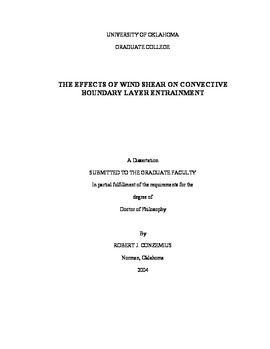| dc.contributor.advisor | Fedorovich, Evgeni, | en_US |
| dc.contributor.author | Conzemius, Robert J. | en_US |
| dc.date.accessioned | 2013-08-16T12:19:29Z | |
| dc.date.available | 2013-08-16T12:19:29Z | |
| dc.date.issued | 2004 | en_US |
| dc.identifier.uri | https://hdl.handle.net/11244/773 | |
| dc.description.abstract | 24 large eddy simulations (LES) were conducted for CBLs growing under varying conditions of surface buoyancy flux, free atmospheric stratification, and wind shear. With the intent of elucidating the effects of surface layer shear versus shear at the CBL top, the simulations were divided into three categories: a free atmosphere with no mean wind (NS), an atmosphere with a height-constant geostrophic wind of 20 m/s (GC), and a case with strong shear in the geostrophic wind (GS). The entrainment predictions of LES were then compared with predictions from two 1.5-order, e-l turbulence models based on the Reynolds-Averaged Navier-Stokes (RANS) and with two bulk models based on integral budgets of CBL buoyancy, momentum, and turbulence kinetic energy (TKE): the zero order model (ZOM) and the first order model (FOM). | en_US |
| dc.description.abstract | In the LES cases, the sheared CBLs grew fastest, relative to the shear-free CBLs when the surface buoyancy flux was weak and the atmospheric stratification was moderate or weak. From the simulations, there are two fundamental findings. The first is that the entrainment zone shear is much more important than the surface shear in enhancing CBL entrainment. The other is the discovery of a layer of constant Ri that forms within the entrainment zone when the relative effects of shear stand out strongly enough. | en_US |
| dc.description.abstract | Tests of RANS-based e-l closures against the LES data show that the e-l closures exaggerate the differences between the entrainment rates of shear-free CBLs and sheared CBLs. The entrainment rate predicted by e-l closures for sheared CBLs is too large, regardless of whether the modeled entrainment zone TKE is larger or smaller than that in LES. It is possible that the formulation of the master length scale l for CBL turbulence needs to be reduced when shear is a significant source of TKE. | en_US |
| dc.description.abstract | The current study examines the dynamics of entrainment and the evolution of the dry atmospheric convective boundary layer (CBL) when wind shear is present and seeks to make comprehensive tests of existing hypotheses regarding the effects of wind shear on entrainment and the parameterizations that have been developed from them. | en_US |
| dc.description.abstract | The comparisons between LES and the lidar data for the May 22, 2002 sheared CBL case show that CBL depth comparisons can be made relatively easily when a suitable atmospheric sampling strategy is used. However, the observed CBL growth rates differed considerably from LES, underscoring the fact that atmospheric processes not simulated in LES have a significant influence on the CBL depth. Despite these problems, the conclusions based on the simulation results need to be tested more fully against atmospheric data. | en_US |
| dc.description.abstract | The tests of the ZOM parameterizations using LES data highlighted their mathematical deficiencies, which caused them to fail when shear was strong. When the full FOM equations were integrated using an entrainment zone depth limited by a critical Richardson number (Ri), they were able to model some of the sheared CBL cases in which ZOM fails. Based on the FOM and LES results and the results of testing other parameterizations, any Ri-limited entrainment equation would seem to be most suited to model the dynamics of entrainment in sheared CBLs. Despite its shortcomings, the ZOM places the shear-free CBLs in a common framework from which they can be easily compared to sheared CBLs. | en_US |
| dc.format.extent | xvii, 338 leaves : | en_US |
| dc.subject | Boundary layer (Meteorology) | en_US |
| dc.subject | Enthalpy. | en_US |
| dc.subject | Physics, Atmospheric Science. | en_US |
| dc.subject | Wind shear. | en_US |
| dc.title | The effects of wind shear on convective boundary layer entrainment. | en_US |
| dc.type | Thesis | en_US |
| dc.thesis.degree | Ph.D. | en_US |
| dc.thesis.degreeDiscipline | School of Meteorology | en_US |
| dc.note | Source: Dissertation Abstracts International, Volume: 65-07, Section: B, page: 3502. | en_US |
| dc.note | Adviser: Evgeni Fedorovich. | en_US |
| ou.identifier | (UMI)AAI3138958 | en_US |
| ou.group | College of Atmospheric & Geographic Sciences::School of Meteorology | |
